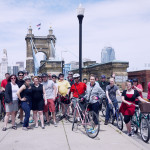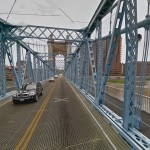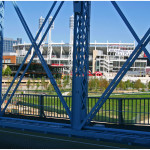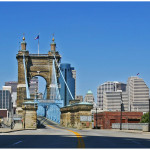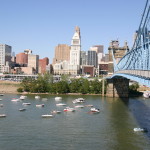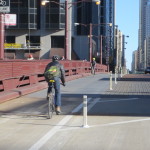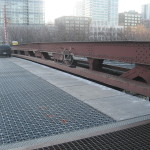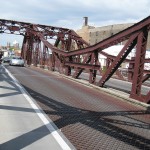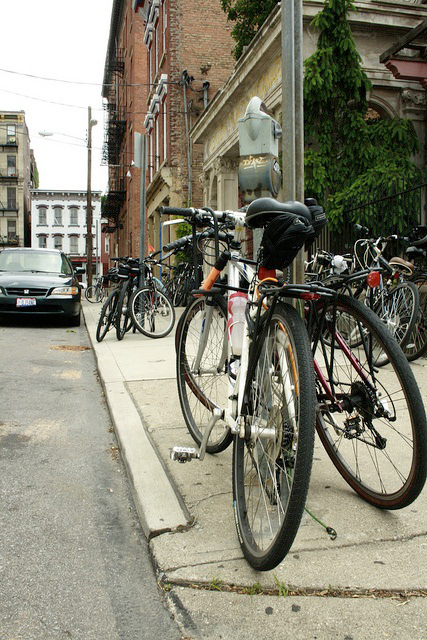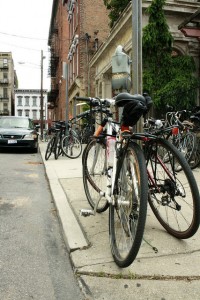In the spirit of throwing new ideas out there, UrbanCincy would like to propose installing Kathy Plates on the Roebling Suspension Bridge in order to improve the safety of bicyclists, pedestrians and motorists using the 148-year-old span.
The idea first came to mind when we hosted our Bikes+Brews ride in May 2013. The route took our group of approximately 20 cyclists across the bridge. Following the law, and protecting the safety of pedestrians also using the bridge, we rode across with automobile traffic.
Those familiar with the Roebling Suspension Bridge know that it is somewhat famous for the humming sound it makes as you drive across. Well, this sound is created by the friction between each vehicle’s tires and the grated bridge deck. That same deck that evokes such a pleasant and memorable sound, also can at times redirect a car slightly as it navigates the numerous grooves.
This also occurs for people traveling across the bridge on bicycles, although to a much greater effect due to the lighter weight of the bike compared to the car.
This same phenomenon exists on dozens of Chicago’s famous bascule bridges. The bascule bridge type was invented in Chicago and proved to be an engineering innovation still paying dividends more than 100 years later. The design, however, requires a delicate management of the bridge’s weight distribution – even a new coat of paint has the potential to throw things out of whack.
Chicago has seen an explosion in the number of people using bicycles as their form of transportation, and, as a result, saw many cyclists crashing on the bridges due to the grooves in the grated bridge decks and their joints that are similar to what exist on Cincinnati’s famed Roebling Suspension Bridge.
The Chicago Department of Transportation (CDOT) came up with a solution that aimed to remedy the safety hazard while also respecting the delicate balancing act required to make bascule bridges go up and down.
That solution is the ‘Kathy Plate’ application, which is named after activist Kathy Schubert, who lobbied for the plates after she had crashed on Chicago’s LaSalle Street Bridge.
It is a fiberglass plate that is affixed to the bridge deck where bicyclists would be riding, thus creating a smooth and consistent surface without throwing off the bridge’s weight distribution.
Mike Amsden, Assistant Director of Transportation Planning with CDOT, told UrbanCincy that the city initially used steel plates or concrete infill, but has since switched to the fiberglass alternative due to its lower cost and lighter weight. As of today, Chicago has one bridge with steel plates, seven with concrete infill, and five with the new fiberglass plate option.
Amsden says that CDOT first began using the fiberglass plates more than two years ago, and has not yet needed to replace any of them – even with Chicago’s harsh winters.
“The open grate bascule bridges can be very slippery, especially when wet,” Amsden explained. “Because bridges can be such a barrier to bicycling, we’re putting extra emphasis on making our bridges bicycle friendly.”
CDOT says that they incorporate these fiberglass plates on any bike lane project that crosses a bridge, and uses the concrete infill option on bridges that are being reconstructed, regardless of whether a bike lane crosses the bridge.
“We match the plate width to the approaching and departing bike lane width,” said Amsden. “So, as you can see on Dearborn, it’s a wide two-way bike land, so the plates are much wider.”
There are no marked bike lanes approaching or departing from the Roebling Suspension Bridge, but cyclists typically use the congested and winding sidewalks cantilevered outside of the bridge columns.
A simple application of these fiberglass plates in each direction could help to improve safety and mobility on Cincinnati’s most iconic bridge.
According to Queen City Bike, it is something they said they would like to research further and consider for potential application on the Roebling Suspension Bridge.

